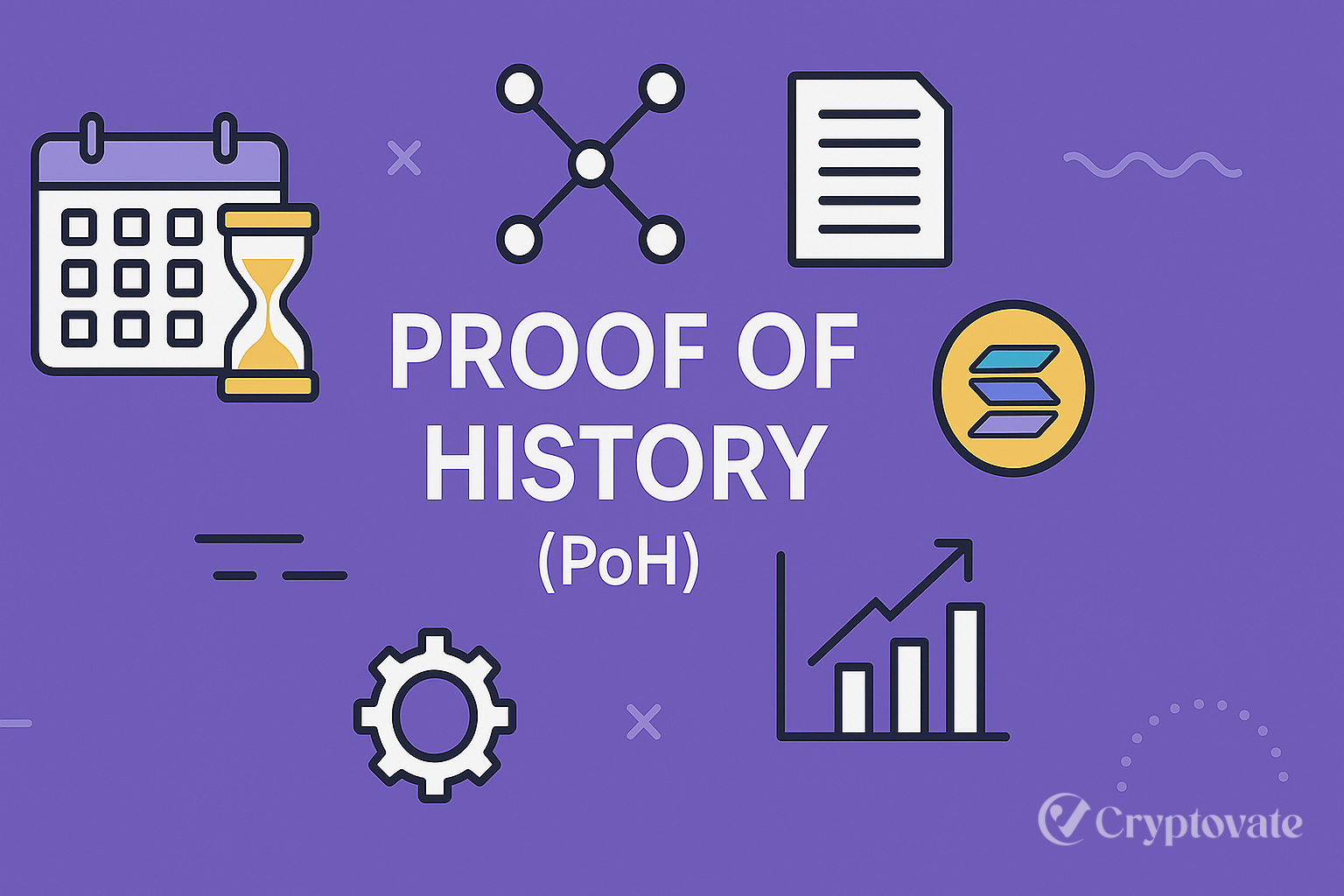– Ad –
| Getting your Trinity Audio player ready... |
Proof of History (PoH) is an innovative concept in blockchain technology that enhances the efficiency and scalability of decentralized networks. Unlike traditional consensus mechanisms like Proof of Work (PoW) or Proof of Stake (PoS), PoH is not a standalone consensus algorithm but a cryptographic tool that improves how blockchains record and verify the passage of time. Introduced by Solana, a high-performance blockchain, PoH allows for faster transaction processing and greater throughput, making it a game-changer for decentralized applications (dApps).
In this article, we’ll break down what Proof of History is, how it works, its benefits, and why it matters in the world of blockchain. Let’s dive in!
What is Proof of History (PoH)?
Proof of History is a cryptographic mechanism that generates a secure, sequential, and verifiable log of events on a blockchain. It ensures that transactions are timestamped in a way that proves their order without requiring nodes to communicate extensively. Think of it as a digital notary that guarantees events happened in a specific sequence, making it easier for the network to agree on the state of the blockchain.
Unlike PoW, which relies on computational puzzles, or PoS, which depends on staking tokens, PoH focuses on creating a historical record of transactions using a verifiable delay function (VDF). This allows Solana to process thousands of transactions per second (TPS) while maintaining security and decentralization.
How Does Proof of History Work?
At its core, PoH uses a cryptographic function to generate a sequence of hashes that act as a timeline for the blockchain. Here’s a simplified explanation of how it works:
- Sequential Hashing: PoH relies on a cryptographic hash function (like SHA-256) that takes an input, produces a unique output (hash), and feeds it back into the function. This generates a sequence of hashes, each linked to the previous one, creating a verifiable chronological record.
- Verifiable Delay Function (VDF): The hashing process is computationally intensive and takes a specific amount of time to complete. This ensures that the sequence cannot be manipulated or sped up without redoing the work, making it secure.
- Timestamping Transactions: Each hash in the sequence acts as a timestamp. Transactions are attached to these hashes, proving their order in time. Nodes can verify this order without needing to trust other nodes or synchronize clocks.
- Integration with Consensus: In Solana’s case, PoH works alongside a Proof of Stake-based consensus mechanism called Tower BFT. PoH provides the timeline, while Tower BFT ensures agreement on the blockchain’s state.
This combination allows Solana to process transactions quickly, as nodes don’t need to wait for extensive communication to confirm the order of events.
Why is Proof of History Important?
Proof of History addresses some of the biggest challenges in blockchain technology: scalability, speed, and efficiency. Here’s why it stands out:
1. High Transaction Throughput
By creating a verifiable timeline, PoH eliminates the need for nodes to spend time coordinating the order of transactions. This allows Solana to handle up to 65,000 TPS, far surpassing traditional blockchains like Bitcoin (7 TPS) or Ethereum (30 TPS).
2. Low Transaction Costs
With faster processing and less computational overhead, PoH reduces the cost of transactions. This makes it ideal for applications like decentralized finance (DeFi), gaming, and NFTs, where low fees are critical.
3. Enhanced Scalability
PoH enables blockchains to scale without sacrificing decentralization or security. By offloading the time-ordering process to a cryptographic function, nodes can focus on validating transactions, improving network efficiency.
4. Energy Efficiency
Unlike PoW, which requires massive computational power, PoH is energy-efficient. It uses minimal resources to create its cryptographic timeline, making it an eco-friendly alternative.
Benefits of Proof of History
- Speed: Processes transactions in milliseconds, enabling real-time applications.
- Cost-Effective: Lowers transaction fees, making blockchain accessible to more users.
- Scalability: Supports thousands of transactions per second without compromising security.
- Transparency: Creates a verifiable record of events that anyone can audit.
- Compatibility: Works seamlessly with other consensus mechanisms like PoS.
Use Cases of Proof of History
PoH is primarily associated with Solana, but its principles can be applied to other blockchains. Some real-world use cases include:
- Decentralized Finance (DeFi): Fast and cheap transactions make PoH ideal for DeFi platforms handling trading, lending, and yield farming.
- NFT Marketplaces: PoH enables rapid creation and exchange of non-fungible tokens (NFTs).
- Gaming: Blockchain-based games benefit from PoH’s low latency and scalability for in-game transactions.
- Supply Chain Tracking: PoH’s timestamping creates a verifiable record of events for supply chain logistics.
Also Read: Top 10 Crypto Tools to Master the Market in 2025
Proof of History vs. Other Consensus Mechanisms
To understand PoH’s unique value, let’s compare it to other consensus mechanisms:
| Feature | Proof of History (PoH) | Proof of Work (PoW) | Proof of Stake (PoS) |
| Primary Function | Timestamping events | Securing network via computation | Securing network via staking |
| Speed | Very fast (65,000+ TPS) | Slow (7-30 TPS) | Moderate (100-1,000 TPS) |
| Energy Usage | Low | High | Low |
| Scalability | High | Low | Moderate |
| Use Case | High-throughput dApps | Secure cryptocurrencies | General-purpose blockchains |
PoH isn’t a direct replacement for PoW or PoS but complements them by solving the time-ordering problem, making it a powerful tool for modern blockchains.
Challenges and Limitations
While PoH is groundbreaking, it’s not without challenges:
- Complexity: The cryptographic nature of PoH can be difficult to implement and understand.
- Centralization Risks: Solana’s reliance on high-performance hardware for validators has raised concerns about potential centralization.
- Adoption: PoH is primarily used by Solana, limiting its widespread adoption compared to PoW or PoS.
The Future of Proof of History
As blockchain technology evolves, PoH could play a significant role in enabling scalable, high-speed decentralized networks. Its ability to handle thousands of transactions per second makes it a strong contender for applications requiring real-time processing, such as Web3, DeFi, and the metaverse. As more blockchains explore integrating PoH or similar concepts, we may see further innovations in scalability and efficiency.
Conclusion
Proof of History is an innovative solution that addresses blockchain technology’s scalability and speed limitations. By creating a cryptographic timeline, PoH enables networks like Solana to process transactions at lightning speed while maintaining security and decentralization. Its benefits—high throughput, low costs, and energy efficiency—make it a promising tool for the future of decentralized applications.
Whether you’re a blockchain enthusiast or a developer building dApps, understanding Proof of History can give you insight into the next generation of blockchain technology. As the industry grows, PoH could pave the way for faster, more efficient, and accessible decentralized systems.

















